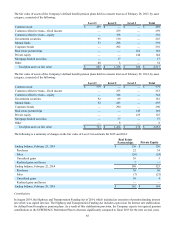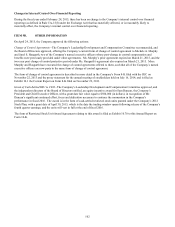Albertsons 2015 Annual Report Download - page 94
Download and view the complete annual report
Please find page 94 of the 2015 Albertsons annual report below. You can navigate through the pages in the report by either clicking on the pages listed below, or by using the keyword search tool below to find specific information within the annual report.
92
losses incurred by Albertson’s LLC or NAI as a result of the intrusions affecting their stores would not be the Company’s
responsibility.
Investigations and Proceedings - As a result of the criminal intrusions, the payment card brands are conducting investigations
into whether the portion of the Company’s network that handles payment card data was compliant with applicable data security
standards at the time of the intrusions and, if not, whether any non-compliance caused any compromise of payment card data
that may have occurred during the intrusions. The Company’s network has previously been found to be compliant with those
standards; however, the forensic investigator working on behalf of the payment card brands has concluded that the Company
was not in compliance at the time of the intrusions and that the alleged non-compliance caused at least some portion of the
compromise of payment card data that allegedly occurred during the intrusions. As a result, the Company expects the payment
card brands to allege that the Company was not compliant with the applicable data security standards at the time of the
intrusions and that such alleged non-compliance caused the compromise of payment card data during the intrusions. The
Company believes the payment card brands will make claims against the Company for non-ordinary course operating expenses
and incremental counterfeit fraud losses allegedly incurred by them or their issuers by reason of the intrusions and the
Company expects to dispute those claims. While the Company does not believe that a loss is probable by reason of these as yet
unasserted claims, the Company believes that a loss in connection with these claims, should they be asserted, is reasonably
possible; however, at this time the Company cannot reasonably estimate a range of possible losses because the payment card
brands’ investigation is ongoing and the payment card brands have not alleged what payment cards they consider to have been
compromised, what data from those cards they consider to have been compromised, or the amount of their and/or their issuers'
claimed losses. The Company does not currently believe that the amount, if any, paid on any payment card brand claims that
might be asserted would be material to the Company’s consolidated results of operations, cash flows or financial condition.
While the Company is not aware of any investigation into the intrusions having been initiated by any regulatory authority, it is
possible that regulatory investigations into the intrusions could be initiated in the future and, were that to occur, it is possible
that such investigations could result in claims being made against the Company by the regulatory authorities in question. If that
were to occur, the Company expects to dispute those claims.
As discussed in more detail below in this Note 14 under Legal Proceedings, four class action complaints have been filed
against the Company related to the intrusions and are currently pending. As indicated in Note 14, the Company believes that the
likelihood of a material loss from the four class actions is remote. It is possible that other similar complaints by consumers,
banks or others may be filed against the Company in connection with the intrusions.
Insurance Coverage - The Company had $50 of cyber threat insurance above a per incident deductible of $1 at the time of the
intrusions and the Company now maintains $75 of cyber threat insurance above a per incident deductible of approximately $3,
in each case subject to certain sublimits, which it believes should mitigate the financial effect of these intrusions, including
claims made or that might be made against the Company based on these intrusions. Based on currently available information,
the Company does not believe that the ultimate outcome of these intrusions, including any related lawsuits, claims or other
proceedings that might be initiated against the Company, will have a material adverse impact on the Company’s consolidated
results of operations, cash flows or financial position.
Expenses - The Company has and expects to incur various costs related to the intrusions, including the cost of conducting the
pending investigation, the cost of providing identity protection services to the Company’s customers and legal and other
professional expenses. In fiscal 2015, the Company recorded $5 of intrusion related costs and anticipated insurance proceeds of
$3. These amounts were recorded within Selling and administrative expenses in the Consolidated Statement of Operations.
Anticipated insurance proceeds recorded for the insurance receivable were based on the Company’s insurance recovery
assessment. This assessment included the review of applicable insurance policies, correspondence with the insurance carriers
and analysis by legal counsel.
Impact on Sales - The Company has not experienced weaker than anticipated sales subsequent to the intrusions.
Other Contractual Commitments
In the ordinary course of business, the Company enters into supply contracts to purchase products for resale and purchase and
service contracts for fixed asset and information technology commitments. These contracts typically include either volume
commitments or fixed expiration dates, termination provisions and other standard contractual considerations. As of
February 28, 2015, the Company had approximately $244 of noncancelable future purchase obligations.
The Company and AB Acquisition entered into a binding term sheet with the PBGC relating to issues regarding the effect of the
sale of NAI on certain SUPERVALU retirement plans. The agreement required that the Company not pay any dividends to its
stockholders at any time for a period of up to five years. The Company had also agreed to make $100 in aggregate
























